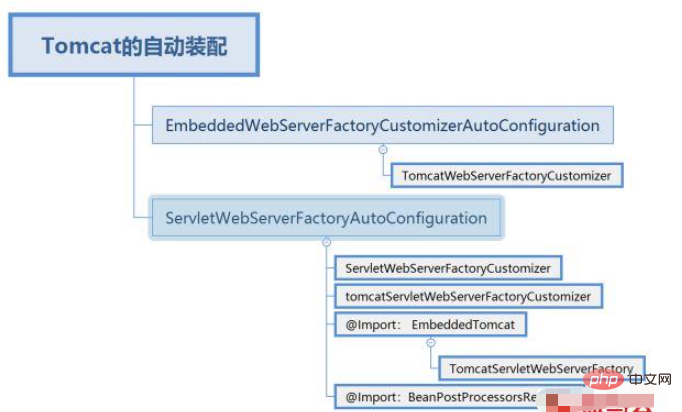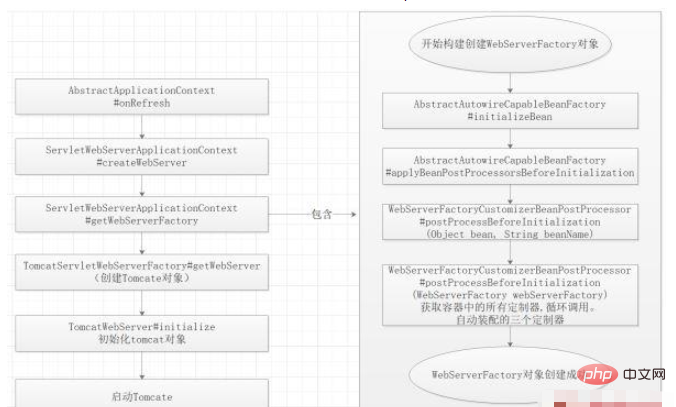springboot中如何利用Tomcat容器實現自啟動
一、Spring透過註解導入Bean大體可分為四種方式,我們主要來說以下Import的兩種實作方法:
1、透過實作ImportSerlector接口,實作Bean載入:
public class TestServiceImpl {
public void testImpl() {
System.out.println("我是通过importSelector导入进来的service");
}
}
public class TestService implements ImportSelector {
@Override
public String[] selectImports(AnnotationMetadata annotationMetadata) {
return new String[]{"com.ycdhz.service.TestServiceImpl"};
}
}
@Configuration
@Import(value = {TestService.class})
public class TestConfig {
}
public class TestController {
@Autowired
private TestServiceImpl testServiceImpl;
@RequestMapping("testImpl")
public String testTuling() {
testServiceImpl.testImpl();
return "Ok";
}
}2、 透過實作ImportSerlector接口,實作Bean載入:
public class TestService {
public TestService() {
System.out.println("我是通过ImportBeanDefinitionRegistrar导入进来的组件");
}
}
public class TestImportBeanDefinitionRegistrar implements ImportBeanDefinitionRegistrar {
@Override
public void registerBeanDefinitions(AnnotationMetadata importingClassMetadata, BeanDefinitionRegistry registry) {
//定义一个BeanDefinition
RootBeanDefinition beanDefinition = new RootBeanDefinition(TestService.class);
//把自定义的bean定义导入到容器中
registry.registerBeanDefinition("testService",beanDefinition);
}
}
@Configuration
@Import(TestImportBeanDefinitionRegistrar.class)
public class TestConfig {
}二、 Springboot啟動過程中會自動組裝
我們從spring-boot-autoconfigure-2.0.6.RELEASE .jar下搜尋到Tomcat的相關配置,發現有兩個自動裝配類,分別包含了三個定制器(面向對象的單一職責原則),還有一個工廠類。

2.1、TomcatWebServerFactoryCustomizer:客製化Servlet和Reactive伺服器通用的Tomcat特定功能。
public class TomcatWebServerFactoryCustomizer implements
WebServerFactoryCustomizer<configurabletomcatwebserverfactory>, Ordered {
@Override
public void customize(ConfigurableTomcatWebServerFactory factory) {
ServerProperties properties = this.serverProperties;
ServerProperties.Tomcat tomcatProperties = properties.getTomcat();
PropertyMapper propertyMapper = PropertyMapper.get();
propertyMapper.from(tomcatProperties::getBasedir).whenNonNull()
.to(factory::setBaseDirectory);
propertyMapper.from(tomcatProperties::getBackgroundProcessorDelay).whenNonNull()
.as(Duration::getSeconds).as(Long::intValue)
.to(factory::setBackgroundProcessorDelay);
customizeRemoteIpValve(factory);
propertyMapper.from(tomcatProperties::getMaxThreads).when(this::isPositive)
.to((maxThreads) -> customizeMaxThreads(factory,
tomcatProperties.getMaxThreads()));
propertyMapper.from(tomcatProperties::getMinSpareThreads).when(this::isPositive)
.to((minSpareThreads) -> customizeMinThreads(factory, minSpareThreads));
propertyMapper.from(() -> determineMaxHttpHeaderSize()).when(this::isPositive)
.to((maxHttpHeaderSize) -> customizeMaxHttpHeaderSize(factory,
maxHttpHeaderSize));
propertyMapper.from(tomcatProperties::getMaxHttpPostSize)
.when((maxHttpPostSize) -> maxHttpPostSize != 0)
.to((maxHttpPostSize) -> customizeMaxHttpPostSize(factory,
maxHttpPostSize));
propertyMapper.from(tomcatProperties::getAccesslog)
.when(ServerProperties.Tomcat.Accesslog::isEnabled)
.to((enabled) -> customizeAccessLog(factory));
propertyMapper.from(tomcatProperties::getUriEncoding).whenNonNull()
.to(factory::setUriEncoding);
propertyMapper.from(properties::getConnectionTimeout).whenNonNull()
.to((connectionTimeout) -> customizeConnectionTimeout(factory,
connectionTimeout));
propertyMapper.from(tomcatProperties::getMaxConnections).when(this::isPositive)
.to((maxConnections) -> customizeMaxConnections(factory, maxConnections));
propertyMapper.from(tomcatProperties::getAcceptCount).when(this::isPositive)
.to((acceptCount) -> customizeAcceptCount(factory, acceptCount));
customizeStaticResources(factory);
customizeErrorReportValve(properties.getError(), factory);
}
}</configurabletomcatwebserverfactory>2.2、ServletWebServerFactoryCustomizer:WebServerFactoryCustomizer 將ServerProperties屬性套用到Tomcat web伺服器。
public class ServletWebServerFactoryCustomizer implements
WebServerFactoryCustomizer<configurableservletwebserverfactory>, Ordered {
private final ServerProperties serverProperties;
public ServletWebServerFactoryCustomizer(ServerProperties serverProperties) {
this.serverProperties = serverProperties;
}
@Override
public int getOrder() {
return 0;
}
@Override
public void customize(ConfigurableServletWebServerFactory factory) {
PropertyMapper map = PropertyMapper.get().alwaysApplyingWhenNonNull();
map.from(this.serverProperties::getPort).to(factory::setPort);
map.from(this.serverProperties::getAddress).to(factory::setAddress);
map.from(this.serverProperties.getServlet()::getContextPath)
.to(factory::setContextPath);
map.from(this.serverProperties.getServlet()::getApplicationDisplayName)
.to(factory::setDisplayName);
map.from(this.serverProperties.getServlet()::getSession).to(factory::setSession);
map.from(this.serverProperties::getSsl).to(factory::setSsl);
map.from(this.serverProperties.getServlet()::getJsp).to(factory::setJsp);
map.from(this.serverProperties::getCompression).to(factory::setCompression);
map.from(this.serverProperties::getHttp2).to(factory::setHttp2);
map.from(this.serverProperties::getServerHeader).to(factory::setServerHeader);
map.from(this.serverProperties.getServlet()::getContextParameters)
.to(factory::setInitParameters);
}
}</configurableservletwebserverfactory>2.3、ServletWebServerFactoryCustomizer :WebServerFactoryCustomizer 將ServerProperties屬性套用到Tomcat web伺服器。
public class TomcatServletWebServerFactoryCustomizer
implements WebServerFactoryCustomizer<tomcatservletwebserverfactory>, Ordered {
private final ServerProperties serverProperties;
public TomcatServletWebServerFactoryCustomizer(ServerProperties serverProperties) {
this.serverProperties = serverProperties;
}
@Override
public void customize(TomcatServletWebServerFactory factory) {
ServerProperties.Tomcat tomcatProperties = this.serverProperties.getTomcat();
if (!ObjectUtils.isEmpty(tomcatProperties.getAdditionalTldSkipPatterns())) {
factory.getTldSkipPatterns()
.addAll(tomcatProperties.getAdditionalTldSkipPatterns());
}
if (tomcatProperties.getRedirectContextRoot() != null) {
customizeRedirectContextRoot(factory,
tomcatProperties.getRedirectContextRoot());
}
if (tomcatProperties.getUseRelativeRedirects() != null) {
customizeUseRelativeRedirects(factory,
tomcatProperties.getUseRelativeRedirects());
}
}
}</tomcatservletwebserverfactory>三、有了TomcatServletWebServerFactory,相當於有了Spring載入的入口
透過AbstractApplicationContext#onReFresh()在IOC 容器中的帶動tomcat啟動,然後在接著執行ioc容器的其他步驟。
我們透過斷點可以觀察Tomcat載入的整個生命週期,以及三個自訂器的載入過程。

@Override
public WebServer getWebServer(ServletContextInitializer... initializers) {
Tomcat tomcat = new Tomcat();
File baseDir = (this.baseDirectory != null) ? this.baseDirectory
: createTempDir("tomcat");
tomcat.setBaseDir(baseDir.getAbsolutePath());
Connector connector = new Connector(this.protocol);
tomcat.getService().addConnector(connector);
customizeConnector(connector);
tomcat.setConnector(connector);
//设置是否自动启动
tomcat.getHost().setAutoDeploy(false);
//创建Tomcat引擎
configureEngine(tomcat.getEngine());
for (Connector additionalConnector : this.additionalTomcatConnectors) {
tomcat.getService().addConnector(additionalConnector);
}
//刷新上下文
prepareContext(tomcat.getHost(), initializers);
//准备启动
return getTomcatWebServer(tomcat);
}private void initialize() throws WebServerException {
TomcatWebServer.logger
.info("Tomcat initialized with port(s): " + getPortsDescription(false));
synchronized (this.monitor) {
try {
addInstanceIdToEngineName();
Context context = findContext();
context.addLifecycleListener((event) -> {
if (context.equals(event.getSource())
&& Lifecycle.START_EVENT.equals(event.getType())) {
// Remove service connectors so that protocol binding doesn't
// happen when the service is started.
removeServiceConnectors();
}
});
// Start the server to trigger initialization listeners
this.tomcat.start();
// We can re-throw failure exception directly in the main thread
rethrowDeferredStartupExceptions();
try {
ContextBindings.bindClassLoader(context, context.getNamingToken(),
getClass().getClassLoader());
}
catch (NamingException ex) {
// Naming is not enabled. Continue
}
// Unlike Jetty, all Tomcat threads are daemon threads. We create a
// blocking non-daemon to stop immediate shutdown
startDaemonAwaitThread();
}
catch (Exception ex) {
stopSilently();
throw new WebServerException("Unable to start embedded Tomcat", ex);
}
}
}備註: 在這個過程中我們需要了解Bean的生命週期,Tomcat的三個自訂器都是在BeanPostProcessorsRegistrar(Bean後置處理器)過程中載入;
建構方法-->Bean後置處理器Before-->InitializingBean-->init-method-->Bean後置處理器After
org.springframework.beans.factory.support.AbstractAutowireCapableBeanFactory#doCreateBean org.springframework.beans.factory.support.AbstractAutowireCapableBeanFactory#initializeBean
protected Object doCreateBean(final String beanName, final RootBeanDefinition mbd, final @Nullable Object[] args)
throws BeanCreationException {
// Instantiate the bean.
BeanWrapper instanceWrapper = null;
if (mbd.isSingleton()) {
instanceWrapper = this.factoryBeanInstanceCache.remove(beanName);
}
if (instanceWrapper == null) {
//构造方法
instanceWrapper = createBeanInstance(beanName, mbd, args);
}
final Object bean = instanceWrapper.getWrappedInstance();
Class> beanType = instanceWrapper.getWrappedClass();
if (beanType != NullBean.class) {
mbd.resolvedTargetType = beanType;
}
// Initialize the bean instance.
......
return exposedObject;
}
protected Object initializeBean(final String beanName, final Object bean, @Nullable RootBeanDefinition mbd) {
if (System.getSecurityManager() != null) {
AccessController.doPrivileged((PrivilegedAction<object>) () -> {
invokeAwareMethods(beanName, bean);
return null;
}, getAccessControlContext());
}
else {
invokeAwareMethods(beanName, bean);
}
Object wrappedBean = bean;
if (mbd == null || !mbd.isSynthetic()) {
//Bean后置处理器Before
wrappedBean = applyBeanPostProcessorsBeforeInitialization(wrappedBean, beanName);
}
try {
invokeInitMethods(beanName, wrappedBean, mbd);
}
catch (Throwable ex) {
throw new BeanCreationException(
(mbd != null ? mbd.getResourceDescription() : null),
beanName, "Invocation of init method failed", ex);
}
if (mbd == null || !mbd.isSynthetic()) {
//Bean后置处理器After
wrappedBean = applyBeanPostProcessorsAfterInitialization(wrappedBean, beanName);
}
return wrappedBean;
}</object>以上是springboot中如何利用Tomcat容器實現自啟動的詳細內容。更多資訊請關注PHP中文網其他相關文章!

熱AI工具

Undresser.AI Undress
人工智慧驅動的應用程序,用於創建逼真的裸體照片

AI Clothes Remover
用於從照片中去除衣服的線上人工智慧工具。

Undress AI Tool
免費脫衣圖片

Clothoff.io
AI脫衣器

Video Face Swap
使用我們完全免費的人工智慧換臉工具,輕鬆在任何影片中換臉!

熱門文章

熱工具

記事本++7.3.1
好用且免費的程式碼編輯器

SublimeText3漢化版
中文版,非常好用

禪工作室 13.0.1
強大的PHP整合開發環境

Dreamweaver CS6
視覺化網頁開發工具

SublimeText3 Mac版
神級程式碼編輯軟體(SublimeText3)
 tomcat如何部署jar項目
Apr 21, 2024 am 07:27 AM
tomcat如何部署jar項目
Apr 21, 2024 am 07:27 AM
若要將 JAR 專案部署到 Tomcat,請遵循以下步驟:下載並解壓縮 Tomcat。配置 server.xml 文件,設定連接埠和專案部署路徑。將 JAR 檔案複製到指定的部署路徑中。啟動 Tomcat。使用提供的 URL 存取已部署的項目。
 tomcat伺服器怎麼能讓外網訪問
Apr 21, 2024 am 07:22 AM
tomcat伺服器怎麼能讓外網訪問
Apr 21, 2024 am 07:22 AM
要讓 Tomcat 伺服器對外網訪問,需要:修改 Tomcat 設定文件,允許外部連接。新增防火牆規則,允許存取 Tomcat 伺服器連接埠。建立 DNS 記錄,將網域名稱指向 Tomcat 伺服器公有 IP。可選:使用反向代理提升安全性和效能。可選:設定 HTTPS 以提高安全性。
 tomcat安裝目錄在哪裡
Apr 21, 2024 am 07:48 AM
tomcat安裝目錄在哪裡
Apr 21, 2024 am 07:48 AM
Tomcat 安裝目錄:預設路徑:Windows:C:\Program Files\Apache Software Foundation\Tomcat 9.0macOS:/Library/Tomcat/Tomcat 9.0Linux:/opt/tomcat/tomcat9自訂路徑:安裝時可指定。尋找安裝目錄:使用 whereis 或 locate 指令。
 tomcat怎麼部署多個項目
Apr 21, 2024 am 09:33 AM
tomcat怎麼部署多個項目
Apr 21, 2024 am 09:33 AM
要透過 Tomcat 部署多個項目,需要建立每個專案的 webapp 目錄,然後:自動部署:將 webapp 目錄放置在 Tomcat 的 webapps 目錄中。手動部署:在 Tomcat 的 manager 應用程式中手動部署專案。專案部署後,可以透過其部署名稱訪問,例如:http://localhost:8080/project1。
 tomcat並發連線數怎麼查看
Apr 21, 2024 am 08:12 AM
tomcat並發連線數怎麼查看
Apr 21, 2024 am 08:12 AM
查看Tomcat並發連線數的方法:造訪Tomcat Manager頁面(http://localhost:8080/manager/html),輸入使用者名稱和密碼。在左側導覽列中點選Status->Sessions,即可在頁面頂部看到並發連線數。
 tomcat網站根目錄在哪裡
Apr 21, 2024 am 09:27 AM
tomcat網站根目錄在哪裡
Apr 21, 2024 am 09:27 AM
Tomcat 網站根目錄位於 Tomcat 的 webapps 子目錄中,用於儲存 Web 應用程式檔案、靜態資源和 WEB-INF 目錄;它可以透過尋找 Tomcat 設定檔中的 docBase 屬性來找到。
 tomcat的連接埠號碼怎麼看
Apr 21, 2024 am 08:00 AM
tomcat的連接埠號碼怎麼看
Apr 21, 2024 am 08:00 AM
Tomcat埠號碼可透過以下方法檢視:檢查server.xml檔案中的<Connector>元素的port屬性。造訪Tomcat管理介面(http://localhost:8080/manager/html)並查看"Status"標籤。在命令列中運行"catalina.sh version"並查看"Port:"行。
 tomcat怎麼配置域名
Apr 21, 2024 am 09:52 AM
tomcat怎麼配置域名
Apr 21, 2024 am 09:52 AM
若要設定 Tomcat 使用域名,請執行下列步驟:建立伺服器.xml 備份。開啟 server.xml 並加入 Host 元素,將 example.com 替換為你的網域。為網域名稱建立 SSL 憑證(如果需要)。在 server.xml 中新增 SSL 連接器,變更連接埠、金鑰庫檔案和密碼。保存 server.xml。重新啟動 Tomcat。






